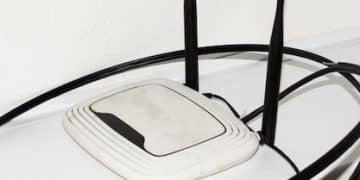Secure Your Home Network: WPA3 Encryption in 5 Steps

Secure Your Home Network: Implementing WPA3 Encryption Protocol in 5 Easy Steps involves upgrading your router’s security settings to use the latest WPA3 standard, which provides enhanced protection against hacking and unauthorized access, thereby keeping your personal data and devices safe from cyber threats.
Is your home network as secure as it could be? In today’s digital world, protecting your data from cyber threats is more crucial than ever. One of the most effective ways to enhance your home’s digital defenses is by implementing Secure Your Home Network: Implementing WPA3 Encryption Protocol in 5 Easy Steps, the latest Wi-Fi security standard.
Understanding WPA3 and Its Advantages
Wi-Fi Protected Access 3 (WPA3) is the latest security protocol for Wi-Fi networks, designed to replace the older WPA2 standard. It offers several significant improvements in security and privacy, making it a crucial upgrade for any home network.
What is WPA3?
WPA3 is the third iteration of the Wi-Fi Protected Access protocol. It addresses many of the vulnerabilities found in WPA2, providing a more robust and secure connection for your devices. This upgraded version features stronger encryption and authentication methods, safeguarding your network from various cyber threats.
Key Benefits of WPA3
- Enhanced Encryption: WPA3 uses more advanced encryption algorithms, making it significantly harder for hackers to crack your Wi-Fi password.
- Improved Authentication: With Simultaneous Authentication of Equals (SAE), WPA3 offers a handshake method that is more resistant to password-guessing attacks.
- Individualized Data Encryption: WPA3 encrypts data transmitted between your devices and the router on an individual basis, preventing hackers from intercepting your data even if they breach the network.
- Protection Against Legacy Weaknesses: WPA3 addresses known vulnerabilities in WPA2, ensuring your network is protected against older attack methods.
By understanding the core advantages of WPA3, homeowners can appreciate the necessity of upgrading their network security. The enhanced encryption, improved authentication, and individualized data encryption provide a more robust defense against modern cyber threats, ensuring a safer online experience for all connected devices.

Step 1: Check Router Compatibility and Firmware
Before you begin the process of implementing WPA3, the first crucial step is to ensure that your router is compatible with the WPA3 protocol and has the latest firmware updates installed. This ensures that your router can effectively support the new security features.
Verifying WPA3 Compatibility
Not all routers support WPA3. Older models, in particular, may lack the necessary hardware or software to run the protocol. Check your router’s documentation or the manufacturer’s website to confirm whether it is WPA3-compatible. Look for terms like “WPA3 support” or “802.11ax compatible” (since WPA3 is often included in Wi-Fi 6 routers).
Updating Router Firmware
Firmware updates are essential for maintaining the security and performance of your router. These updates often include security patches, bug fixes, and support for new features like WPA3. To update your router’s firmware:
- Access the Router’s Admin Panel: Open a web browser and enter your router’s IP address (usually 192.168.1.1 or 192.168.0.1). Log in using your administrator username and password.
- Navigate to Firmware Update: Look for a section labeled “Firmware Update,” “System Update,” or similar. The location varies depending on the router model.
- Check for Updates: Click the button to check for available updates. If an update is available, follow the on-screen instructions to download and install it.
- Reboot the Router: After the update is complete, reboot your router to ensure the changes take effect.
Ensuring your router is both compatible and up-to-date is a foundational step in implementing WPA3. Without this, the subsequent steps will be ineffective. Regularly checking for updates is also a good practice to maintain optimal security and performance.
Step 2: Access Your Router’s Admin Panel
The second step in securing your home network is gaining access to your router’s admin panel. This is where you can configure your router’s settings, including the security protocol. Understanding and navigating this panel is crucial for implementing WPA3.
Finding Your Router’s IP Address
To access the admin panel, you’ll need your router’s IP address. Here are a few ways to find it:
- Windows: Open the Command Prompt and type `ipconfig`. Look for the “Default Gateway” address.
- macOS: Open System Preferences, go to Network, select your Wi-Fi connection, and click “Advanced.” Then, go to the “TCP/IP” tab to find the “Router” address.
- Router Documentation: The IP address is often printed on a sticker on the router itself or in the router’s manual.
Logging into the Admin Panel
Once you have the IP address, follow these steps to log into the admin panel:
- Open a Web Browser: Type the IP address into the address bar of your web browser and press Enter.
- Enter Username and Password: You will be prompted to enter your username and password. If you haven’t changed them, check the router’s documentation for the default credentials. Common default usernames are “admin” and passwords like “password” or an empty field.
- Navigate the Panel: Once logged in, explore the panel to familiarize yourself with the different settings. Look for sections related to wireless settings, security, or Wi-Fi configuration.
Successfully accessing your router’s admin panel is essential for making any configuration changes. Ensure you have the correct IP address and login credentials. If you encounter issues, consult your router’s documentation or contact your internet service provider for assistance.
Step 3: Configure WPA3 Security Settings
After accessing your router’s admin panel, the next crucial step involves configuring the WPA3 security settings. This is where you will enable WPA3 and customize other security options to ensure a robust defense against cyber threats.
Navigating to Wireless Security Settings
Within the admin panel, locate the wireless security settings. This section is usually labeled as “Wireless,” “Wi-Fi,” or “Security.” Click on it to access the configuration options for your wireless network. From there:
- Select WPA3 Mode: In the security settings, you’ll typically find a dropdown menu for choosing the security mode. Select “WPA3 Personal” or “WPA3-SAE.” This will enable the WPA3 protocol for your network. Some routers may offer a “WPA2/WPA3 Transition Mode,” which allows older devices that don’t support WPA3 to still connect securely alongside newer devices.
- Set a Strong Password: WPA3 requires a strong and unique password to maximize security. Choose a password that is at least 12 characters long and includes a mix of uppercase and lowercase letters, numbers, and symbols.
Customizing Advanced Settings
Some routers offer additional settings that can further enhance your network’s security under WPA3. Consider configuring these options:
- Enable PMF (Protected Management Frames): PMF adds an extra layer of security by encrypting management frames, preventing attackers from eavesdropping on your network.
- Disable WPS (Wi-Fi Protected Setup): WPS is known to have security vulnerabilities. Disabling it can prevent unauthorized access to your network.
Configuring WPA3 security settings correctly is vital for reaping the benefits of the new protocol. By setting a strong password, enabling PMF, and disabling WPS, you can create a more secure and resilient home network that is well-protected against potential threats
Step 4: Connect Devices to Your WPA3 Network
With WPA3 enabled on your router, the next step is to connect your devices to the newly secured network. This ensures that all your devices benefit from the enhanced security features of WPA3.
Updating Device Settings
To connect your devices to the WPA3 network, you’ll need to update the Wi-Fi settings on each device:
- Smartphones and Tablets: Go to Settings > Wi-Fi, select your network, and enter the new WPA3 password.
- Laptops and Computers: Open your network settings, select your Wi-Fi network, and enter the WPA3 password when prompted.
- Smart Home Devices: The process varies depending on the device. Some may require you to use a companion app to update the Wi-Fi settings. Others may have a web interface that you can access via a web browser.
Handling Incompatible Devices
Not all devices support WPA3. Older devices, in particular, may only support WPA2 or older protocols. If you have devices that are not WPA3-compatible, consider the following:
- Use WPA2/WPA3 Transition Mode: As mentioned earlier, this mode allows older devices to connect using WPA2 while newer devices connect using WPA3. It provides backward compatibility without compromising security for WPA3-enabled devices.
- Isolate Incompatible Devices: Create a guest network for older devices. This can help segregate them from your primary network, reducing the risk of them being exploited to gain access to your more secure devices.

Connecting all your devices to the WPA3 network is crucial for maximizing the benefits of the new security protocol. Ensure that you update the Wi-Fi settings on each device and consider using the WPA2/WPA3 Transition Mode or isolating incompatible devices to maintain a secure network environment.
Step 5: Test and Monitor Your Network
After implementing WPA3 and connecting your devices, the final step is to test and monitor your network. This ensures that everything is working correctly and that your network remains secure over time.
Testing Network Performance
Once all devices are connected, test your network performance to ensure that the WPA3 implementation has not negatively impacted your internet speed or connectivity.
- Run Speed Tests: Use online speed test tools to measure your upload and download speeds. Compare the results to your previous speeds to identify any significant changes.
- Check Device Connectivity: Ensure that all your devices can connect to the internet and access the resources they need. Pay attention to any devices that experience frequent disconnections or slow speeds.
Monitoring Network Security
Regularly monitoring your network for suspicious activity is crucial for maintaining a secure environment. Here are a few steps you can take:
- Review Router Logs: Most routers keep logs of network activity. Review these logs periodically to look for any unusual or unauthorized access attempts.
- Use Network Monitoring Tools: Consider using network monitoring tools to track the devices connected to your network and monitor their traffic. These tools can alert you to any suspicious activity.
Testing and monitoring your network is an ongoing process. By regularly checking network performance and monitoring for security threats, you can ensure that your home network remains secure and reliable.
| Key Point | Brief Description |
|---|---|
| 🛡️ WPA3 Encryption | Offers enhanced security with stronger encryption algorithms. |
| ⚙️ Router Compatibility | Ensure your router supports WPA3 and update the firmware. |
| 🔑 Strong Password | Use a strong, unique password for optimal security. |
| 📡 Device Connection | Update Wi-Fi settings and handle incompatible devices. |
FAQ
WPA3 is the latest Wi-Fi security protocol, offering enhanced encryption and authentication compared to WPA2. It protects against password-guessing attacks and provides individualized data encryption, securing your home network from cyber threats.
Check your router’s documentation or the manufacturer’s website for WPA3 support. Look for terms like “WPA3 compatible” or “802.11ax compatible.” Also it might be in router’s admin panel.
Use the WPA2/WPA3 Transition Mode on your router to allow older devices to connect using WPA2 while WPA3-compatible devices use the stronger protocol. Otherwise, consider creating a guest network for older devices.
Yes, updating your router’s firmware is essential. The updates often include security patches, bug fixes, and the necessary software to support new features like WPA3, ensuring optimal performance and security.
Regularly review your router logs for unusual access attempts. Additionally, consider using network monitoring tools to track connected devices. These measures can help you quickly identify and address any suspicious or unauthorized activity.
Conclusion
Implementing Secure Your Home Network: Implementing WPA3 Encryption Protocol in 5 Easy Steps is a vital upgrade for home security in the face of rising cyber threats. By following these steps, homeowners can significantly enhance their network’s protection, ensuring a safer online experience for all connected devices, and providing peace of mind in an increasingly connected world.





